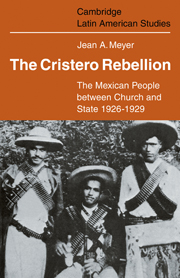Book contents
- Frontmatter
- Contents
- List of illustrations
- Preface
- Chronology of events
- List of abbreviations
- PART I THE CONFLICT BETWEEN CHURCH AND STATE
- PART II THE CRISTEROS
- 5 Church Folk and Townsfolk
- 6 The Recruitment of the Cristeros
- 7 The Cristero Army
- 8 Cristero Government
- 9 The War
- 10 Culture and Religion, Faith and Ideology
- PART III AFTER THE PEACE
- Envoi
- Notes
- Bibliography
- Index
6 - The Recruitment of the Cristeros
Published online by Cambridge University Press: 05 April 2013
- Frontmatter
- Contents
- List of illustrations
- Preface
- Chronology of events
- List of abbreviations
- PART I THE CONFLICT BETWEEN CHURCH AND STATE
- PART II THE CRISTEROS
- 5 Church Folk and Townsfolk
- 6 The Recruitment of the Cristeros
- 7 The Cristero Army
- 8 Cristero Government
- 9 The War
- 10 Culture and Religion, Faith and Ideology
- PART III AFTER THE PEACE
- Envoi
- Notes
- Bibliography
- Index
Summary
Geographical Background
Every geographical account of an insurrection has an element of ambiguity: rebellion develops both where men wish to rebel and where they are capable of doing so. Abstention is difficult to analyse, because it may stem from a lack of willingness or a lack of opportunity; finally, the negative factors may prove insufficient to deter men from the moment when the desire to fight has become strong enough. One must, therefore, bear in mind that recruitment is not the same at the beginning as it is at the end of the rebellion, that it fluctuates over the course of time. The near-unanimous participation characteristic of the beginning, which is more in the nature of an assembly than a rising, is replaced by a process of individual commitment that varies according to local circumstances. Thus one sees recruits, in growing numbers and in regions as yet only slightly affected, overcoming measures of intimidation which are already proving effective, because everybody knows that the war is terrible and that it will be long.
Participation in the insurrection is not only governed by geographical, historical, and social factors, but also by psychological considerations. The Federal general Cristobal Rodríguez, who commanded the Querétaro zone, declared that ‘the same fanaticism’ reigned everywhere; nevertheless ‘the perfidious efforts of the Clergy did not achieve the same results in every place’.
- Type
- Chapter
- Information
- The Cristero RebellionThe Mexican People Between Church and State 1926–1929, pp. 83 - 113Publisher: Cambridge University PressPrint publication year: 1976



